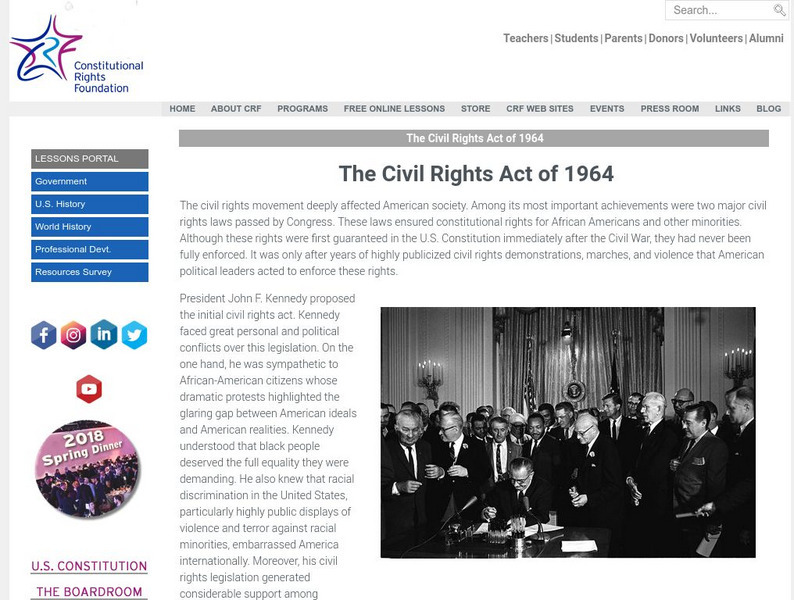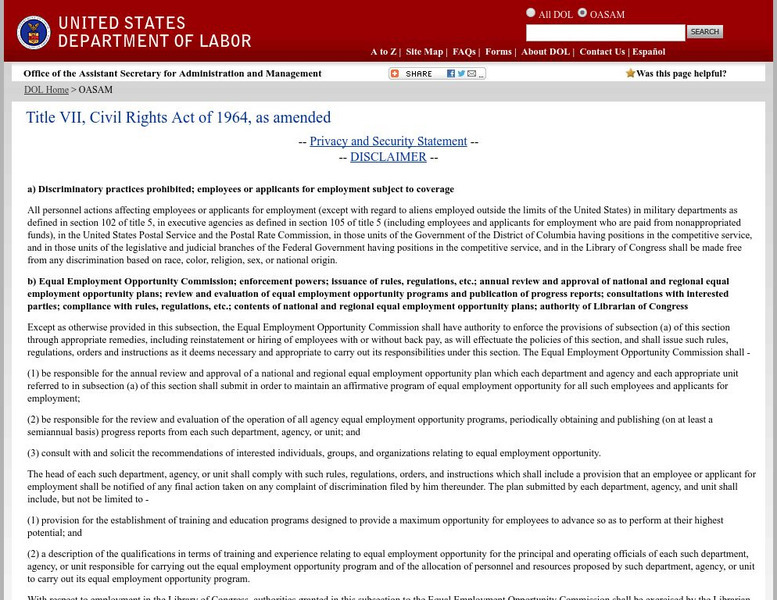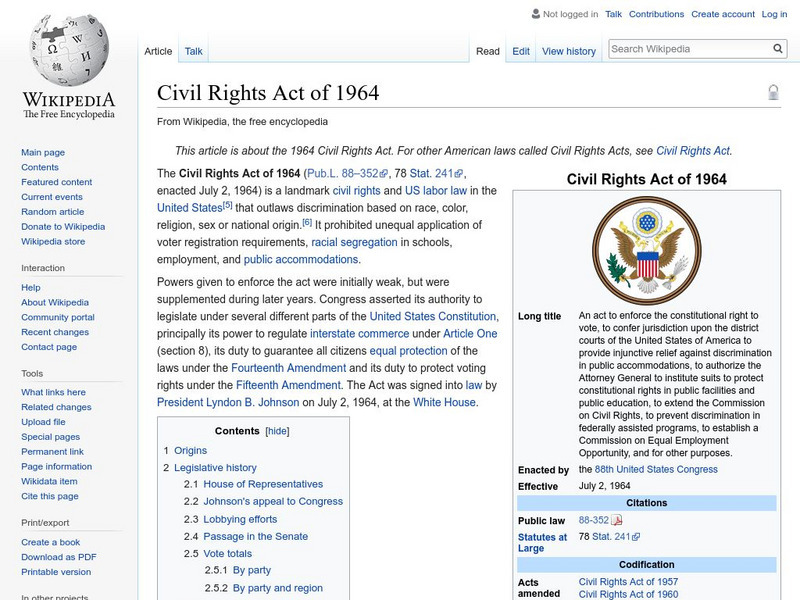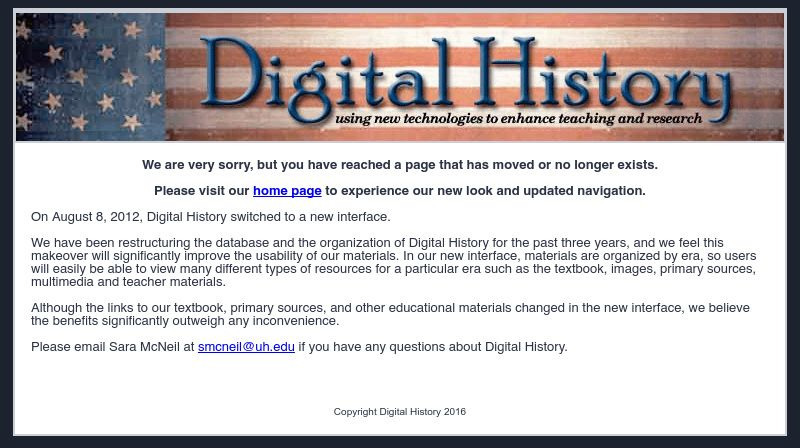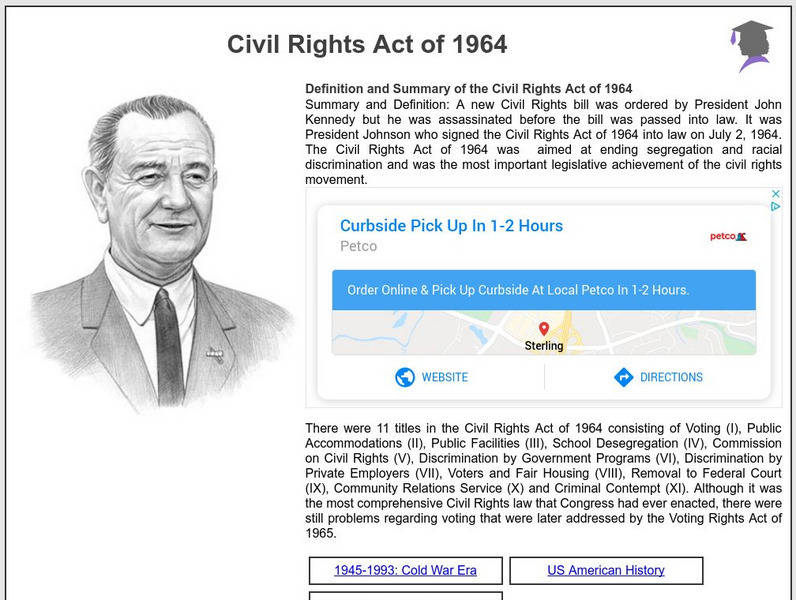Hi, what do you want to do?
PBS
Pbs Learning Media: Documenting Brown: Civil Rights Act of 1964
The Civil Rights Act of 1964 helped enforce the Brown ruling, a decade later.
US National Archives
Nara: Teaching With Documents: Civil Rights Act of 1964 and the Eeoc
The Civil Rights Act of 1964 prohibited not only discrimination based on race, but also gender. Use this lesson plan to explore the document, particularly Title VII in examining the law.
Khan Academy
Khan Academy: The Civil Rights Act of 1964 and the Voting Rights Act of 1965
Read about the Civil Rights Act of 1964 and the Voting Rights Act of 1965 which sought to make discrimination illegal, and the resistance they faced from the public and government officials. As time passed, African Americans began to...
Other
Encyclopedia Virginia: Civil Rights Act of 1964
A detailed look at the Civil Rights Act of 1964, paying particular attention to how Virginia Representative Howard W. Smith added an amendment intended to kill the act by making it cover gender discrimination as well as racial. Read...
Constitutional Rights Foundation
Constitutional Rights Foundation: The Civil Rights Act of 1964
Read about the persisitence of President Lyndon B. Johnson in finally enacting the momentous civil rights legislation, the Civil Rights Act of 1964. Find out about his adversaries and allies in getting this legislation passed.
US Department of Labor
U.s. Department of Labor: Text of the Civil Rights Act of 1964
US Department of Labor provides this government copy of the Civil Rights Act of 1964. Thorough and complete, all the necessary information is provided.
US National Archives
Our Documents: Civil Rights Act (1964)
Find an image of the Civil Rights Act of 1964, signed by President Lyndon Johnson on July 2, 1964. Read a brief description of how this life-changing legislation came to be.
Stanford University
Sheg: Document Based History: Reading Like a Historian: Civil Rights Act of 1964
[Free Registration/Login Required] JFK was known for being supportive of the Civil Rights Movement. In this lesson, young scholars will review two speeches and evaluate the devotion the President had to civil rights.
Stanford University
Mlk and the Global Freedom Struggle: Civil Rights Act of 1964
Read about President John F. Kennedy's role in attempting to outlaw segregation, and, after Kennedy's assassination, President Johnson's role in making that happen with the passage of the Civil Rights Act of 1964.
Wikimedia
Wikipedia: Civil Rights Act of 1964
This is a detailed explanation as to what the Civil Rights Act of 1964 was, how it came about, and how it affected American society. Includes a photograph of President Lyndon Johnson signing the Civil Rights Act into law.
US National Archives
Docsteach: Civil Rights Act, 1964 & Equal Employment Opportunity Commission
This activity asks young scholars to read, analyze, and summarize Title VII of the Civil Rights Act of 1964 that established the Equal Employment Opportunity Commission.
Library of Congress
Loc: American Women: Civil Rights Act of 1964
The Civil Rights Act of 1964 was not focused just on racial civil rights, but also gender equity. This site from the Library of Congress deals with how women could use the legislation in lawsuits charging discrimination.
Northern Illinois University
Illinois Periodicals Online: Everett Dirksen and the 1964 Civil Rights Act
Read about the use of the filibuster in the U.S. Senate as a way to control legislation.In the discussion of the Civil Rights Act of 1964, the longest filibuster in history was launched as a way to keep the legislation from coming to a...
Digital History
Digital History: Civil Rights Act of 1964
A brief description of the Civil Rights Act of 1964, the opposition against it, and how the law prohibited discrimination in voting, housing, public facilities, and employment.
Siteseen
Siteseen: American Historama: Civil Rights Act of 1964
Learn about the Civil Rights Act of 1964 that was aimed at ending segregation and racial discrimination.
National Endowment for the Humanities
Neh: Edsit Ement: Civil Rights Movement
This lesson plan on the Civil Rights movement is organized into three sections: "Identifying the Need for Change," "Ordinary People in the Civil Rights Movement," and "Historic Places in the Civil Rights Movement."
Texas Education Agency
Texas Gateway: The American Civil Rights Movement: An Overview
Given primary and secondary resources, students will be able to trace the historical development of the civil rights movement in the 19th, 20th, and 21st centuries, and describe the roles of political organizations that promoted civil...
Ducksters
Ducksters: Civil Rights for Kids: Civil Rights Act of 1964
Kids learn about the history of the Civil Rights Act of 1964 including the background and work by leaders such as President John F. Kennedy, President Lyndon Johnson, and Martin Luther King, Jr on this site.
University of Groningen
American History: Documents: George C. Wallace Speech: The Civil Rights Movement
View the complete speech by Alabama governor George Wallace condemning the Civil Rights Act.
National Geographic
National Geographic: The Impact of the Jfk Assassination on American Politics
Students investigate the impact John F. Kennedy's assassination has had on American politics since that event. After his death, Lyndon B. Johnson pushed through the Civil Rights Act of 1964 and the Voting Rights Act, both of which had...
University of Virginia
Virginia Center for Digital History: Television News of the Civil Rights Era
A rich collection of streaming video samples of television news footage from 1950 to 1970, along with an assortment of primary source documents, first-person accounts, a glossary of terms, and essays and analysis for learning about the...
PBS
Pbs Learning Media: Civil Rights Special Collection
Multimedia collection of video, primary text documents and audio on Civil Rights, especially Brown vs. Board of Education.
PBS
Wnet: Thirteen: Rise and Fall of Jim Crow: A National Struggle: Congress
This two-page segment of a larger PBS site about Jim Crow discusses the role of Congress over close to 100 years in first entrenching Jim Crow laws in the law of the land, and eventually, through the Civil Rights Act of 1965 and the...
Other
National Council for the Social Studies: Cloture Motion to Cease Debate
Using the Civil Rights Bill of 1964 as an example, students will understand the congressional procedures of cloture and filibuster. An in-depth article on how a filibuster was used during debate on this bill, the actual signed cloture...








